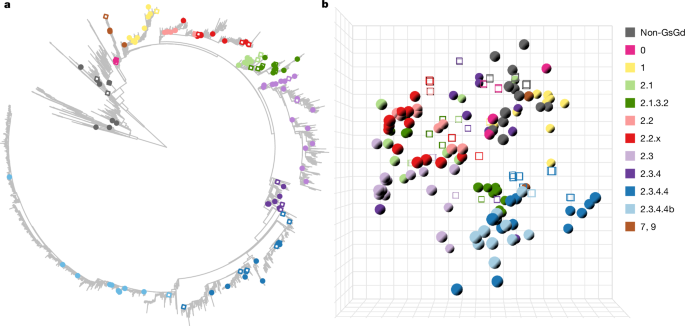A vaccine central in A(H5) influenza antigenic space confers broad immunity
Article metadata
Article Date: 15 October 2025
Article URL: https://www.nature.com/articles/s41586-025-09626-3
Article Image: https://media.springernature.com/lw685/springer-static/image/art%3A10.1038%2Fs41586-025-09626-3/MediaObjects/41586_2025_9626_Fig1_HTML.png
Summary
The study builds a high-resolution three-dimensional antigenic map of A(H5) haemagglutinins (HAs) using haemagglutination inhibition data from a large panel of historical and recent viruses and ferret sera. The authors show that A(H5) antigenic evolution is non-directional and relatively constrained in space, meaning that an antigen designed to sit centrally in antigenic space could elicit broad cross-reactive immunity across diverse A(H5) viruses.
Using those insights, the team rationally engineered candidate vaccine antigens (CVAs) by altering receptor-binding residues (Q222L, G224S), removing a glycosylation site (T156A) and, after egg-passaging, adding T134A to stabilise the construct. The optimised antigen (AC-Anhui: A/Anhui/1/2005 T134A,T156A,Q222L,G224S) produced an immune response in ferrets that was higher, broader and more centred in antigenic space than the wild-type HA counterpart.
In vaccination–challenge experiments, AC-Anhui VACC conferred non-inferior — and in some measures superior — protection against two genetically and antigenically distinct challenge viruses (H5N1 Giza and H5N6 Sichuan) compared with homologous vaccines. Vaccination notably reduced lower-respiratory viral replication, disease severity and extra-respiratory spread (including brain spread for the H5N1 challenge).
The work establishes antigenic cartography as a tool to design antigenically central A(H5) vaccine antigens as a practical pre-pandemic strategy and argues for follow-up human immunogenicity studies and consideration of pairing central HAs with matched NAs and alternative vaccine platforms.
Key Points
- A 3D antigenic map of A(H5) HAs (117 antigens, 29 ferret sera) reveals complex, non-directional antigenic evolution requiring more than two dimensions to describe.
- Antigenic and genetic distances are partially discordant: small antigenic changes can arise from few amino-acid substitutions near the receptor-binding site.
- ‘Central’ antigens in the map (close to the map centre) are naturally more cross-reactive; most lack a glycosylation site at position 154 and some show partial α2,6 sialic-acid binding.
- Rationally engineered CVAs (Q222L, G224S, T156A ± T134A) shifted non-central HAs closer to the antigenic centre and increased HI reactivity across diverse A(H5) antigens.
- The optimised AC-Anhui antigen induced broader and higher HI responses in ferrets and provided non-inferior protection vs homologous vaccines against two antigenically distinct challenge viruses, reducing lung titres and extrarespiratory spread.
- Antigenically central vaccines could serve as early pandemic or pre-pandemic primes to confer variant-agnostic pre-immunity while a strain-matched vaccine is produced.
- Limitations: immunogenicity assessment relied primarily on HI assays (neutralisation, non-neutralising antibodies and T-cell responses need further study), and the relative contributions of receptor-binding changes versus glycosylation removal remain to be dissected.
- Next steps suggested: human immunogenicity trials, combining central HAs with matched NAs, evaluation on alternative platforms (mRNA, vectored vaccines), and mapping NA antigenic evolution.
Context and relevance
A(H5) goose/Guangdong lineage HPAIVs are enzootic in birds and have caused widespread animal outbreaks and mammalian spillover, with substantial human-case fatality in past zoonoses. Current WHO practice selects multiple candidate vaccine viruses (CVVs) repeatedly because A(H5) antigenic diversity is broad; manufacturing strain-matched inactivated vaccines is slow and often poorly immunogenic in naive populations. This study offers a proactive antigen-design approach that could simplify early pandemic response by providing broader initial coverage and buying time while a matched vaccine is developed.
Author style
Punchy: This is the sort of paper you should not skim. The authors don’t just map A(H5) antigenic chaos — they use the map to design a vaccine antigen that actually works across diverse strains in ferrets. If pandemic preparedness matters to you, the technical detail here (mutations, antigenic positioning, ferret outcomes) is worth a proper read.
Why should I read this?
Short version: want a smarter, less reactive way to prepare for H5 pandemics? These researchers made an antigen that sits in the middle of the H5 antigenic map and gives broad protection in ferrets. It’s practical, evidence-driven and points to a realistic pre-pandemic strategy — so yeah, this saves you time and tells you what to watch next.

